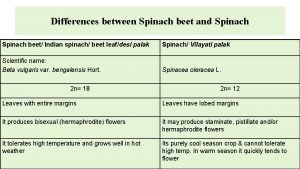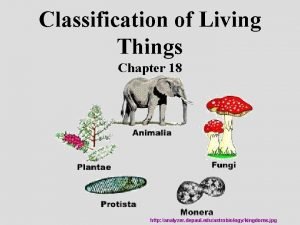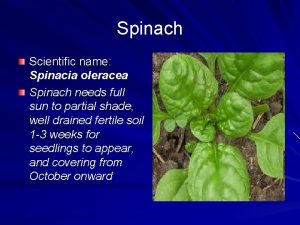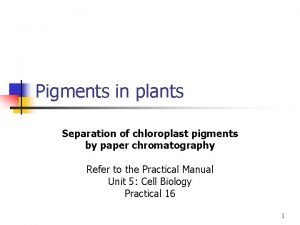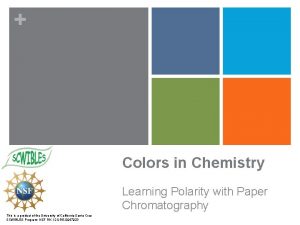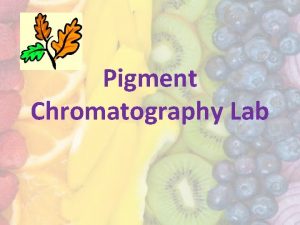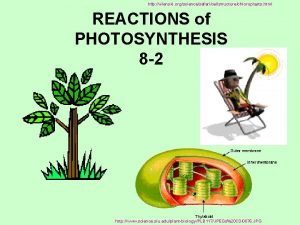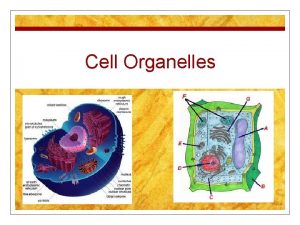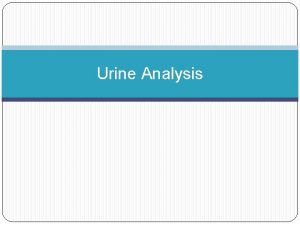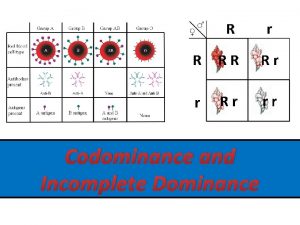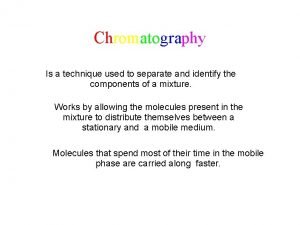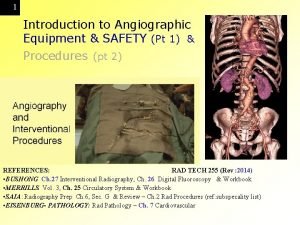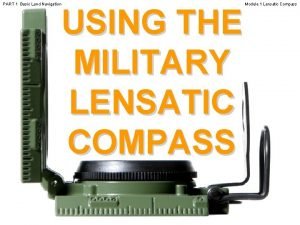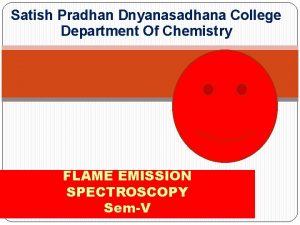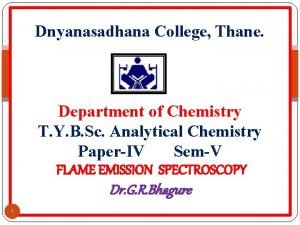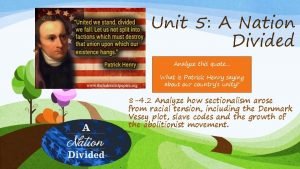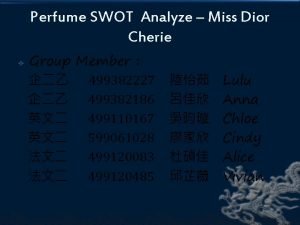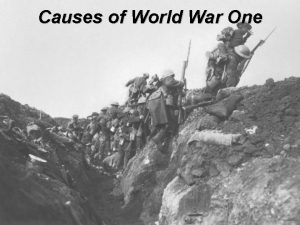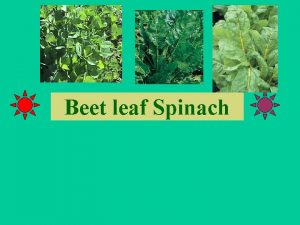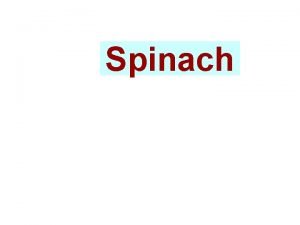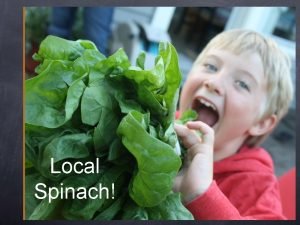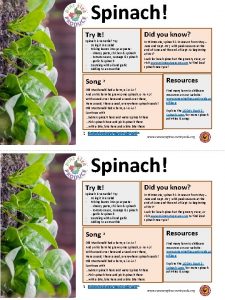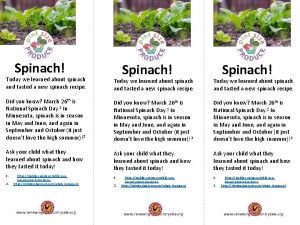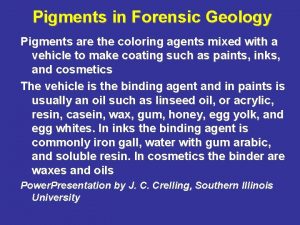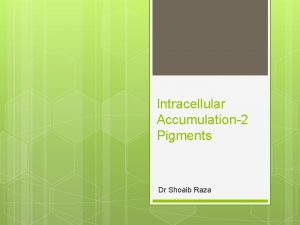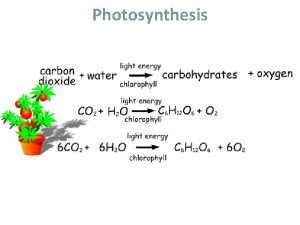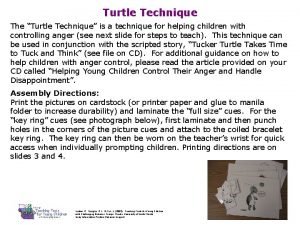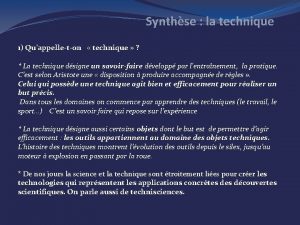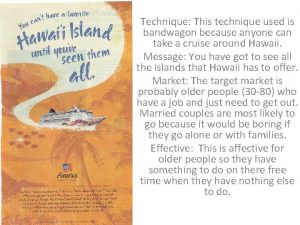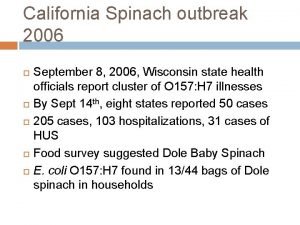A technique used to analyze pigments in spinach































- Slides: 31

A technique used to analyze pigments in spinach leaves is shown in the this diagram. This technique is known as (1) paper chromatography (2) gene manipulation (3) Dissection (4) staining

A valuable medicine is obtained from a certain rare species of plant. Scientists are anxious to find another more abundant species of plant that is closely related to the rare one, and also produces the medicine. Two newly discovered plant species, A and B, were studied and compared to the rare one. The results of the study are shown in the table. Which newly discovered species is more closely related to the rare species? Support your answer. B Species: _______ Same number of chromosomes, leaf shape, and enzymes. ___________________________________

A valuable medicine is obtained from a certain rare species of plant. Scientists are anxious to find another more abundant species of plant that is closely related to the rare one, and also produces the medicine. Two newly discovered plant species, A and B, were studied and compared to the rare one. The results of the study are shown in the table. Which procedure could also be carried out to help determine which newly discovered species is most closely related to the rare species? (1) measurement of respiration rate in the plants (2) chromatography of pigment extracts from the plants (3) determination of the type of gas released by photosynthesis in the plants (4) analysis of chemical bonds present in glucose in the plants

DNA samples were collected from four children. The diagram represents the results of a procedure that separated the DNA in each sample. Gel electrophoresis Band X represents the (1) largest fragment of DNA that traveled the fastest (2) smallest fragment of DNA that traveled the fastest (3) largest fragment of DNA that traveled the slowest (4) smallest fragment of DNA that traveled the slowest The DNA is most similar in which two children? Support your answer. Child B & Child D have the same size bands ________________________________

A student squeezed a clothespin as many times as possible in a 30 second time period. The student repeated this procedure nine more times in quick succession. The data are in the chart below. What is a possible hypothesis that was being tested? (1) Squeezing a clothespin for 30 seconds is not as easy as squeezing for 15 seconds. (2) The number of times I squeeze a clothespin will decrease with multiple tries. (3) The number of clothespin squeezes will cause the number of trials to increase. (4) I wonder how many times in 30 seconds I can squeeze a clothespin? What is the independent variable here?


Which statement best describes a controlled experiment? (1) It eliminates the need for dependent variables. (2) It shows the effect of a dependent variable on an independent variable. (3) It avoids the use of variables. (4) It tests the effect of a single independent variable.

D RN NA A T A C G G C A GUGU VAL Fill in the missing m. RNA bases and the amino acid sequence that corresponds to the DNA base sequence below. CAC CUG ACU HIS LEU THR

Which statement best describes a controlled experiment? (1) It eliminates the need for dependent variables. (2) It shows the effect of a dependent variable on an independent variable. (3) It avoids the use of variables. (4) It tests the effect of a single independent variable.

A student squeezed a clothespin as many times as possible in a 30 second time period. The student repeated this procedure nine more times in quick succession. The data are in the chart below. What is a possible hypothesis that was being tested? (1) Squeezing a clothespin for 30 seconds is not as easy as squeezing for 15 seconds. (2) The number of times I squeeze a clothespin will decrease with multiple tries. (3) The number of clothespin squeezes will cause the number of trials to increase. (4) I wonder how many times in 30 seconds I can squeeze a clothespin? What is the independent variable here?

The diagram shows a laboratory set-up used by students in a biology class. After a day, what is a likely observation a student may make? 1. The solution outside the membrane will change to white 2. The solution outside the membrane will change to yellow 3. The solution inside the membrane will change to yellow 4. The solution inside the membrane will change to black

The cactus finch, warbler finch, and woodpecker finch all live on one island. Based on the information in the diagram below, which one of these finches is least likely to compete with the other two for food? Support your answer with an explanation.

Which three codons would code for a different amino acid sequence from that coded for by the m. RNA base sequence AGU-UCA-CCA? (1) AGC-UCU-CCU (2) AGU-UCC-CCG (3) AGC-UCA-CUU (4) AGU-UCG-CCC


A student observes a red onion cell with a compound light microscope using low, then high power. The two views are represented below. The best explanation for the changes observed by the student is that, when switching from low to high power, the (1) diameter of the field of view decreases (2) slide was accidentally moved (3) diameter of the field of view increases (4) image is inverted and reversed

A student observes a red onion cell with a compound light microscope using low, then high power. The two views are represented below. Which diagram represents the best cell location in the low-power field of view to be sure the entire cell will be visible after switching to high power?

Which statement best describes a controlled experiment? (1) It eliminates the need for dependent variables. (2) It shows the effect of a dependent variable on an independent variable. (3) It avoids the use of variables. (4) It tests the effect of a single independent variable.

There are two types of variables!!!! Independent You “control” this. It is what you are testing. It comes from your hypothesis. You know it BEFORE the experiment even starts. Dependent You measure this during the experiment. It is what you want to know. It is what you compare. You DO NOT KNOW THIS until the experiment occurs.

s t s i t en i c s. r k e r h o t w O r u o y k c e h c Reasons for conducting peer review include all of the following except (1) analyzing the experimental design (2) pointing out possible bias (3) identifying an illogical conclusion (4) changing data to support the hypothesis

An experimental setup is shown in the diagram below. Which hypothesis would most likely be tested using this setup? (1) Green water plants release a gas in the presence of light. (2) Roots of water plants absorb minerals in the absence of light. (3) Green plants need light for cell division. (4) Plants grow best in the absence of light.

What is the independent variable here? The light!

An experiment tested whether water plants make less Oxygen with less light. The bubbles of Oxygen were measured. Which variables are THE SAME between the groups? The plants, the water, the glass beakers…

An experiment tested whether water plants make less Oxygen with less light. The bubbles of Oxygen were measured. Which single variable was changed? The constant light for 24 hours

An experiment tested whether water plants make less Oxygen with less light. The bubbles of Oxygen were measured. Which is the INDEPENDENT VARIABLE? The light! (YOU change this on purpose)

An experiment tested whether water plants make less Oxygen with less light. The bubbles of Oxygen were measured. Which is the DEPENDENT VARIABLE? The Oxygen bubbles. (THE LIGHT changes this. )

# of Oxygen Bubbles The graph might look like this… Amount of Light Which is the INDEPENDENT VARIABLE? The Light. Which is the DEPENDENT VARIABLE? The Oxygen bubbles.

Insecticides are used by farmers to destroy crop-eating insects. Recently, scientists tested several insecticides to see if they caused damage to chromosomes. Six groups of about 200 cells each were examined to determine the extent of chromosome damage after each group was exposed to a different concentration of one of two insecticides. The results are shown: What was the sample size? Which insecticide has a more damaging effect on chromosomes? HOW DO YOU KNOW?

Insecticides are used by farmers to destroy crop-eating insects. Recently, scientists tested several insecticides to see if they caused damage to chromosomes. Six groups of about 200 cells each were examined to determine the extent of chromosome damage after each group was exposed to a different concentration of one of two insecticides. The results are shown: What was the sample size? Which insecticide has a more damaging effect on chromosomes? Support your answer.

A scientist is planning to carry out an experiment on the effect of heat on the function of a certain enzyme. Which would not be an appropriate first step? (1) doing research in a library (2) having discussions with other scientists (3) completing a data table of expected results (4) using what is already known about the enzyme

An experimental design included references from prior experiments, materials and equipment , and step-by-step procedures. What else should be included before the experiment can be started? (1) a set of data (2) a conclusion based on data (3) safety precautions to be used (4) an inference based on results

A student squeezed a clothespin as many times as possible in a 30 -second time period. The student repeated this procedure nine more times in quick succession. The data are in the chart below. What is a possible hypothesis that was being tested? (1) Squeezing a clothespin for 30 seconds is not as easy as squeezing for 15 seconds. (2) The number of times I squeeze a clothespin will decrease with multiple tries. (3) The number of clothespin squeezes will cause the number of trials to increase. (4) I wonder how many times in 30 seconds I can squeeze a clothespin? What is the independent variable here?
 Palak and spinach difference
Palak and spinach difference Binomial nomenclature of humans
Binomial nomenclature of humans Kids prefer cheese over fried green spinach
Kids prefer cheese over fried green spinach Spinach scientific name
Spinach scientific name Spinach rf values
Spinach rf values Paper chromatography and polarity
Paper chromatography and polarity Plant pigments chart
Plant pigments chart Plants gather energy with light-absorbing pigments called *
Plants gather energy with light-absorbing pigments called * What is stomata
What is stomata This organelle contains pigments of all colors except green
This organelle contains pigments of all colors except green Bile salts in urine
Bile salts in urine Co dominance with example
Co dominance with example The primary pigment colors are ____.
The primary pigment colors are ____. Surface-treated pigments
Surface-treated pigments 8. an accounting device used to analyze transactions.
8. an accounting device used to analyze transactions. 8. an accounting device used to analyze transactions.
8. an accounting device used to analyze transactions. 4. an accounting device used to analyze transactions.
4. an accounting device used to analyze transactions. Chromatography is a technique used to separate
Chromatography is a technique used to separate India vocal styles
India vocal styles Technique used
Technique used Which technique is used almost exclusively for sighting
Which technique is used almost exclusively for sighting Bandwagon propaganda images
Bandwagon propaganda images Transfer persuasive technique
Transfer persuasive technique Propaganda techniques in animal farm
Propaganda techniques in animal farm In a premix burner used in fes the fuel used is
In a premix burner used in fes the fuel used is In a premix burner used in fes the fuel used is
In a premix burner used in fes the fuel used is Analyze this quote
Analyze this quote Perfume swot analysis
Perfume swot analysis Analyze text for intent
Analyze text for intent Garvillo princip
Garvillo princip Affective objectives
Affective objectives Job analysis vs job description vs job specification
Job analysis vs job description vs job specification
